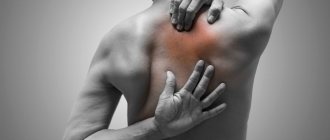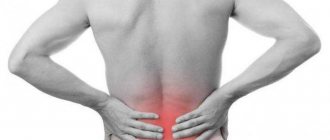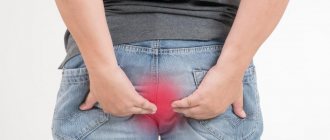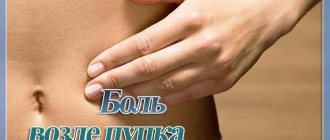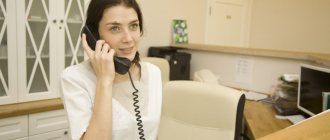13 July 2020
17628
0
4.3 out of 5
Painful sensations in the lower back are no less typical for women than for men. They can occur against the background of various factors, including quite dangerous diseases and physiological causes. Therefore, it is important to be able to distinguish manifestations of banal fatigue and overwork from signs of pathological changes, and if you suspect the occurrence of the latter, seek qualified medical help. After all, one of the consequences of non-intervention in the presence of certain diseases accompanied by back pain can be disability.
Physiological causes of low back pain in women
One of the main natural causes of back discomfort in women is hormonal fluctuations throughout life. They occur during adolescence, every month during the reproductive period, during pregnancy and at the onset of menopause. In each of these cases, the level of some hormones in the body increases and others decrease. Against the background of complete health, such processes are physiological and do not cause any dangerous changes in the functioning of individual organs and entire systems. But with existing disorders, fluctuations in hormone levels can cause a number of diseases, some of which may be accompanied by lower back pain.
The appearance of aching, weak pain more than 2 times a month in non-pregnant women of reproductive age is a sign of abnormalities and requires consultation with a specialist.
Thus, the physiological causes of low back pain in women are:
- menses;
- pregnancy;
- menopause
Also, discomfort of varying severity in the lumbar region can occur after a hard day at work or active work in the gym or on the ground. It is caused by overstrain of the back muscles and goes away on its own. Sometimes too much stress on the lower back can cause muscle and ligament strains. In such cases, the pain is more acute, which requires consultation with a specialist and the creation of the most gentle conditions for the lower back in order to avoid rupture of muscles and ligaments.
Pregnancy
Pregnancy is a difficult period for every woman’s body. Over the 40 weeks from conception to birth, a lot of changes occur in it, ranging from hormonal changes to a sharp increase in weight, a shift in the center of gravity and an increase in the natural deflection in the spine. This leads to the almost inevitable occurrence of lower back pain of varying degrees of intensity. If they are not accompanied by bloody vaginal discharge and are not acute in nature, they are regarded as a variant of the norm.
But at the same time, physiological changes for pregnancy contribute to the exacerbation of chronic diseases and the manifestation of those that were previously hidden. They also create the preconditions for the development of new disorders, especially in the spine. Therefore, kidney pathologies, osteochondrosis, protrusions and intervertebral hernias are often diagnosed during pregnancy. All this can also be signaled by lower back pain.
Climax
The decline of a woman’s reproductive function is accompanied by a decrease in estrogen production and an increase in the production of other hormones. This leads to so-called hot flashes, mood swings, as well as pressure surges and sometimes lower back pain.
But back discomfort during menopause often does not indicate menopausal changes themselves, but the development of osteoporosis, i.e., a decrease in bone density. This, in turn, can lead to disruption of the integrity of the vertebral bodies and the occurrence of compression fractures of the spine.
Why does my lower back hurt?
The following factors may be the reason:
- long periods of driving or working at a computer in a sitting position;
- physical activity, emotional or nervous stress at work;
- intensive training in the gym (when performing exercises in a standing or sitting position);
- pregnancy and difficult childbirth;
- problems with excess weight.
Pain in the lumbar region can occur for various reasons
It happens that the pain goes away on its own. This makes it clear that if the lower back bothers you regularly, the development of a serious disease is possible. And if not treated in a timely manner, it can lead to serious consequences, which will have to be treated with surgical intervention.
Diseases that cause lower back pain in women
Very often, lower back pain in women is a consequence of the development of various diseases. There are quite a few different pathologies for which back discomfort is one of the first signs. This is typical for gynecological diseases and kidney diseases. But more often, lower back pain is the result of the onset and progression of pathologies of the lumbar spine, including:
- osteochondrosis;
- protrusions and intervertebral hernias;
- scoliosis;
- in rare cases, tumors of benign and malignant nature;
- spinal fractures, etc.
Predispose to the development of such disorders:
- excessive physical activity;
- passive lifestyle;
- obesity;
- large breast size;
- habit of slouching;
- wearing the wrong shoes;
- heredity, etc.
Gynecological diseases
Inflammatory and non-inflammatory diseases of the ovaries, fallopian tubes and uterus can be accompanied by pain of varying intensity in the back. They are often accompanied by painful sensations in the lower abdomen, and sometimes by the appearance of various types of vaginal discharge.
Therefore, lower back pain can occur against the background of:
- cystic formations in the ovaries;
- uterine polyps;
- endometriosis.
Kidney diseases
Pyelonephritis, renal failure, glomerulonephritis are almost always accompanied by pain in the lumbar region. Most often, they are observed only on one side and are accompanied by pain, increased frequency of urination, and a change in the color of urine.
Also, lower back pain in women can be caused by urolithiasis and the movement of stones through the ureters. This is accompanied by sharp, severe pain and the appearance of traces of blood in the urine.
Osteochondrosis
Osteochondrosis is the name given to degenerative-dystrophic changes in the intervertebral discs, which are located between the vertebral bodies. They are cartilaginous formations, the shape of which can be roughly called round. Inside each disc there is a nucleus pulposus, which has a gelatinous consistency. It is surrounded by a dense fibrous ring, ensuring the constancy of the disc shape.
Under the influence of high loads, a sedentary lifestyle, pregnancy and other factors, they begin to actively wear out and dehydrate. This leads to a decrease in their height, which is accompanied by lower back pain in women.
If treatment is not started in a timely manner, under the influence of pressure from the vertebral bodies, the nucleus pulposus will flatten more strongly and put pressure on the fibrous ring. Since its fibers lose elasticity during degenerative processes, they gradually rupture, which creates the preconditions for the formation of protrusions and intervertebral hernias.
Protrusions and intervertebral hernias
Protrusion is the protrusion of a disc into the spinal canal, where the spinal roots and the spinal cord itself pass. It is formed as a result of tearing of part of the fibers of the fibrous ring and its deformation, but while maintaining the integrity of the outer part. Protrusions can compress the nerves passing at the level of the discs of the lumbar spine and provoke radicular syndrome, i.e. pain will be present in the lower back and radiate to the legs.
Back discomfort usually occurs after prolonged standing, sitting, or physical activity. In the absence of rest, it tends to intensify and sometimes become unbearable.
In the absence of competent, comprehensive treatment, the fibrous ring eventually ruptures, and the nucleus pulposus is able to partially leak into the spinal canal. This is how a herniated disc forms. At the moment of rupture of the fibrous ring, a woman may feel a sharp pain, which gradually passes and relief occurs. As the pressure inside the disc equalizes, the pain temporarily subsides, which is often mistakenly perceived as an improvement. But soon they resume and become more pronounced, since the hernia puts stronger pressure on all structures passing inside the spinal canal at the level of the lesion.
Additionally, there are sensory disturbances in areas innervated by the affected nerves. More or less pronounced limitations in mobility are observed.
Scoliosis
Scoliotic deformity of the spine often occurs in adolescence, but if it is not noticed and corrected, the disease can progress and cause discomfort in adult women. Pregnancy especially contributes to its aggravation.
The pathology is accompanied by back pain of varying severity, which directly depends on the degree of scoliosis. Its presence can be suspected by the asymmetrical position of the pelvic bones, legs, and waist triangles. Also, the curvature of the ridge is noticeable when bending forward along the shoulder blade protruding on one side and the back is distorted. If left untreated, scoliosis will progress, pain will intensify, and internal organs will also suffer, as they will shift from their natural positions.
Tumors
Spinal tumors are not as rare as they might seem. Quite often, benign formations are found, in particular vertebral hemangiomas (vascular tumors). Also, the spine and surrounding tissues can become the site of metastases of malignant tumors of other organs.
Regardless of their nature, neoplasms tend to grow and compress nerves, muscles, blood vessels and gradually destroy the vertebrae. If they are located in the lumbar spine, lower back pain of varying intensity occurs. This is accompanied by increased fatigue, and the pain syndrome is difficult to eliminate or cannot be eliminated with traditional painkillers.
Spinal fractures
Spinal fractures are most common in older women who have already entered menopause. They can even appear from a sudden movement or lifting a heavy object, and at a younger age they are more often the result of impacts, accidents and falls.
In older women, spinal fractures may not be accompanied by severe pain. Often there is only mild discomfort, which causes such a dangerous pathology to be diagnosed untimely. In other cases, a spinal fracture causes severe pain and provokes serious impairment of motor functions.
Expert opinion
Lower back pain: what to do? Do not make sudden movements, especially if the pain occurs as a result of a fall or blow. Try to take the most comfortable position. If the pain is acute and does not subside when changing position, call an ambulance - renal colic is likely, which requires hospitalization. In other cases, you can use ointments and tablets to alleviate the condition. Contact a specialist as soon as possible. The doctor will help relieve even severe pain and prescribe treatment.
Types of lower back pain in women
Pain in the lower back can have a different character and manifest itself with different severity in different conditions. These criteria allow doctors to make a correct assessment of the situation and suggest where to look for the cause of back pain.
A signal that a woman needs to consult a specialist as soon as possible and begin treatment is acute pain in the lower back. Its appearance is a protective reaction of the body to a developing degenerative-dystrophic or inflammatory process. After all, pain becomes a consequence of irritation of the nerves by altered tissues. This leads to spasm of the back muscles, which further increases the discomfort.
The pain can be nagging, aching, dull or pressing. They can be a consequence of overstrain of the back muscles, hormonal changes, and if they persist for a long time - chronic inflammatory or degenerative processes. Therefore, if such lower back pain occurs in women more often than 1-2 times a month and persists for more than a few days, you should also make an appointment with a doctor.
Often, women with back pain begin to use painkillers and ointments or gels on their own. Such remedies do not help eliminate the causes of discomfort, but only temporarily relieve pain, while the pathology continues to progress and cause complications.
Treatment
Discomfort in the lower back does not occur for no apparent reason. Particular attention is paid to the diagnostic procedure, which allows you to detect this problem and prescribe the correct treatment. Some causes cannot be treated even after two weeks. Each disease requires its own approach and treatment methods, but in most cases complex therapy is used.
For minor pain and complications, such as pregnancy or menstruation, it is allowed to use traditional methods of treatment. After diagnosis and determination of the disease, with the permission of the doctor, you can use traditional medicine painkillers. It makes no difference which side the lower back hurts, right or left; the use of painkillers is allowed in all cases.
Here are a few recipes that will help you get rid of annoying pain and finally focus on your business:
- A tincture of elecampane root helps a lot for pain in the lower back. To make a tincture, you need to take about five grams of roots and place it in boiling water. You should drink one tablespoon several times a day;
- A similar tincture, but based on horsetail, is also good for relieving pain. To do this, you need to take no more than twenty grams of roots and put them in boiling water. You need to drink 40–50 milliliters about once an hour;
- You can also take about 35 grams of celery roots and place them in a glass of plain water. All this should brew well. After a few hours, start taking the tincture, drinking a small glass twice a day;
- You can make a tincture of dried raspberry leaves. For 70 grams of leaves, two glasses of boiling water are enough. It is recommended to drink the tincture twice an hour for several days.
Herbal infusions are well suited for pregnant women and girls during menstruation. They do not harm the body and safely affect nerve endings.
Diagnosis of the causes of pain syndrome
In order to determine the causes of lower back pain, women are advised to consult a neurologist, vertebrologist, urologist or gynecologist. If you have doubts about what disease provoked the disorder, you can make an appointment with a therapist, who will refer the patient for a consultation with the right specialist.
To diagnose diseases that cause back pain, the following are used:
- UAC and OAM;
- blood chemistry;
- Ultrasound of the kidneys and pelvic organs;
- X-ray of the spine;
- CT;
- MRI;
- electroneuromyography.
To diagnose spinal pathologies, it is most preferable to use MRI, since this method, while absolutely safe for human health, can provide the most accurate information about the condition of the intervertebral discs, spinal cord, nerves and other structures. This will allow you to detect even minor protrusions and prescribe appropriate treatment.
Diagnosis
First of all, patients turn to a therapist, who conducts a full examination of the whole body and prescribes laboratory tests. If the patient exhibits symptoms characteristic of gynecological, degenerative or oncological pathologies, the doctor makes an appointment with a highly specialized doctor. This could be a vertebrologist, gynecologist, rheumatologist or oncologist.
These specialists check the patient using instrumental analysis methods. A gynecologist can use ultrasound to study the condition of a pregnant woman and a patient with gynecological diseases. This is a safe diagnostic method that uses ultrasound waves to obtain an informative clinical picture. Polyps, cysts and endometriosis are clearly visible on the monitor, so a specialist can easily determine their location and prescribe surgical treatment.
In the case of cancerous tumors or injuries of the lower back, the doctor prescribes a CT or MRI of the spine. Computed tomography is well suited for older people, when the effect of radioactive substances on the body is much less. Magnetic resonance imaging allows you to examine the body of a young woman or teenager using electromagnetic waves.
MRI is performed in open-type machines, which allows patients with fear of claustrophobia to be diagnosed. During the scan, the patient must lie still for about 15–20 minutes.
Conservative treatment of low back pain
Treatment tactics are developed for each patient separately. First of all, it depends on the diagnosis and the presence of concomitant diseases. Since lower back pain in women is most often caused by diseases of the spine, we will dwell on them in more detail.
Patients are always prescribed comprehensive treatment aimed at both reducing pain and eliminating the causes that caused it. The nature of therapy is selected strictly individually. It often includes:
- drug therapy;
- physiotherapy and massage;
- Exercise therapy.
It is important for patients to make changes to their own lifestyle and diet. If you are overweight, you should take measures to reduce it, as well as rationalize physical activity. In other words, it is important to avoid overstraining the lower back, stop carrying heavy objects, but also not lead a sedentary lifestyle. Office workers, seamstresses and representatives of other “sedentary” professions are recommended to take daily walks, as well as leave the workplace every hour for at least a few minutes. Swimming will also greatly benefit your spine.
Conservative therapy is effective only in the early stages of the development of pathological changes in the spine. At later stages, the situation can only be corrected through surgery.
Drug therapy
For most spinal diseases, the drug treatment of low back pain in women is based on drugs from the following groups:
- NSAIDs;
- corticosteroids;
- muscle relaxants;
- B vitamins.
Other medications may also be prescribed, which the doctor selects for a particular patient, based on her state of health. For severe pain, blockades can be performed. The procedures involve the injection of an anesthetic solution with a corticosteroid directly into the area where the nerves pass. Blockades are effective only for neurological pain and can only be performed by highly qualified medical personnel in medical institutions, otherwise there is a high risk of complications.
Physiotherapy and massage
For vertebrogenic pain, procedures are prescribed that produce an anti-inflammatory, analgesic, and antispasmodic effect. Additionally, physiotherapy and massage improve blood circulation and tissue trophism, which contributes to their speedy recovery. Therefore, the courses most often used are:
- electrophoresis;
- magnetic therapy;
- UHF;
- laser therapy.
Exercise therapy
Therapeutic physical education plays a serious role in the fight against pain and diseases of the spine. With the help of an individually selected set of exercises and its daily implementation, it is possible to strengthen weakened back muscles and activate blood circulation. This will help the reparative processes proceed faster and create additional support for the spine.
Diseases of the genitourinary system
Pain in the lumbar region is sometimes associated with diseases of the genital area or pathologies of the urinary system. This is indicated by fever, intoxication, weakness, appetite and sleep disturbances, and rapid weight loss. Pain on one side or throughout the lower back may, for example, be a sign of pyelonephritis (unilateral or bilateral, respectively) - an inflammatory pathology of the kidneys. Signs of genitourinary diseases:
- pain in the urethral area;
- yellow, greenish, brown discharge;
- change in urine color;
- frequent or infrequent urination;
- false urge to urinate;
- increase in the volume of the lower abdomen;
- menstrual irregularities;
- itching, pain, swelling in the perineum.
If such symptoms appear, you should urgently consult a doctor: many gynecological and kidney diseases are life-threatening and require hospital treatment, in some cases surgical treatment.
Surgical treatment of low back pain
Unfortunately, many women do not seek help when lower back pain first appears. Therefore, very often already advanced degenerative-dystrophic and other changes are diagnosed, when improvement of the condition can only be achieved through surgery.
Surgical intervention is indicated for:
- ineffectiveness of conservative therapy;
- severe spinal fractures;
- large-sized hernias and protrusions, provoking pronounced radicular syndrome;
- severe scoliotic deformity.
The current level of development of spinal surgery makes it possible to carry out complex operations with minimal risks and without leaving noticeable scars on the patient’s skin. There are many different methods of surgical care for women with lower back pain, the specific one of which is selected based on the diagnosis and the degree of advanced disease.
In the vast majority of cases, the following is indicated:
- Nucleoplasty and hydroplasty are operations to remove protrusion of the intervertebral disc, performed under local anesthesia using thin needles. Therefore, after them there is not the slightest scar left on the skin, and the pathological protrusion is removed using cold plasma, radio waves, laser or liquid pressure. One of the advantages of the operation is that the woman can return home almost immediately after it, but it cannot be used for large hernias.
- Microdiscectomy is a surgical intervention that allows you to thoroughly assess the condition of the vertebral structures, remove the hernia, release pinched nerve fibers, and, if necessary, completely resect the disc.
- Vertebroplasty and kyphoplasty are operations performed in cases of spinal fractures, as well as the formation of tumors, in order to close the resulting defects and destroy benign tumors by filling them with special bone cement, which completely hardens in 10 minutes.
- Operations using metal structures – metal structures are used when it is necessary to fix the vertebral bodies in the desired position, for example, in case of scoliosis or after removal of intervertebral discs, etc.
Today, to replace removed intervertebral discs, since protrusions and hernias are the most common causes of back pain in women, endoprostheses are often used, which have the same functions and properties as natural intervertebral discs. This allows, after successful completion of the rehabilitation period, to completely forget that there was previously a problem in the lumbar spine.
Thus, lower back pain is not uncommon for women. But you cannot ignore them, because they can indicate the development of severe pathologies. Therefore, we recommend that you seek medical help as early as possible.
Diseases of the spine and joints
Osteoporosis
This is the most common cause of pain in women. With age, bone tissue becomes fragile and brittle. During menopause, women stop releasing the hormone estrogen, which is responsible for preserving bone tissue. At the same time, the vertebrae lose their elasticity and are often deformed. Osteochondrosis occurs, which affects the intervertebral discs and surrounding tissues.
To prevent osteoporosis, women are recommended to perform special physical exercises to strengthen their muscles and take calcium supplements. In addition, it is worth reducing or stopping the consumption of caffeine, alcohol and nicotine to avoid rapid depletion of bone tissue.
Arthrosis, arthritis, and back pain significantly worsen our quality of life. Sometimes it is simply impossible to calmly raise your arm, step on your leg, or get out of bed without experiencing pain and discomfort.
Diseases of the vertebrae and intervertebral structures often develop in older people - they belong to the group of degenerative-dystrophic pathologies and tend to progress slowly, periodically exacerbating (in the off-season). It happens that diseases of the spine appear in childhood or at a young age and can be caused by infection (tuberculosis), poor posture (scoliosis), and can also be inherited (Bechterew's disease).
